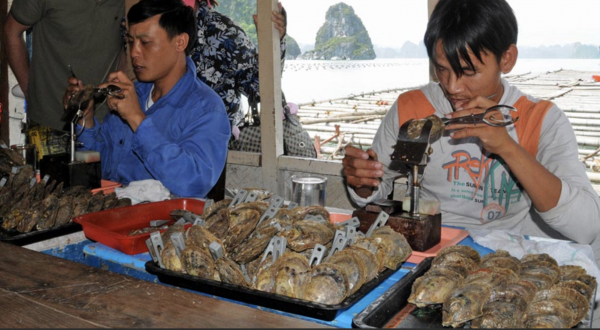Pearl is the birthstone for June and the gem of the third and thirtieth anniversaries. Perhaps the best-loved gems of all time, pearls—natural and cultured—occur in a wide variety of colors. The most familiar are white and cream, but the palette of colors extends to every hue. Natural pearls form around a microscopic irritant in the bodies of certain mollusks. Cultured pearls are the result of the deliberate insertion of a bead or piece of tissue that the mollusk coats with nacre.

A Chinese historian writes about pearls for the first time.
In 1917, Pierre Cartier traded a double strand of natural pearls for a mansion on Fifth Avenue in New York City.
Kokichi Mikimoto successfully cultures a pearl in Japan.
- MINERAL: Calcium Carbonate
- CHEMISTRY: CaCO3
- COLOR: White, black, gray, yellow, orange, pink, lavender, green, blue
- REFRACTIVE INDEX: 1.52-1.69
- SPECIFIC GRAVITY: 2.60-2.85
- MOHS HARDNESS: 2.5-3.0
There are a number of processes used to alter the color, apparent clarity, or improve the durability of gems. LEARN MORE
Some gemstones have synthetic counterparts that have essentially the same chemical, physical, and optical properties, but are grown by man in a laboratory. LEARN MORE
Any gem can be imitated—sometimes by manmade materials or by natural materials chosen by man to impersonate a particular gem. LEARN MORE
WHY WE LOVE THIS GEMSTONE
- 1LUSTER
Luster results from reflection of light rays off the pearl’s surface, and from concentric inner layers of nacre, like light bouncing off a convex mirror.
- 2IMITATIONS
Imitation pearls are smooth when rubbed against your teeth, while natural or cultured pearls have a slightly rough texture.
- 3NATURAL PEARLS
Natural pearls can be separated from cultured pearls by taking X-rays to reveal their inner structures.
QUALITY FACTORS
An assessment of the following characteristics determines the value of each type of pearl.
- LUSTER
Pearls with high luster have sharp bright reflections on the surface.
- SURFACE QUALITY
The number of blemishes on a pearl’s surface is evaluated to judge quality.
- SHAPE
Spherical pearls are the most valued but symmetrical drops are also sought.
- COLOR
Although white is most classic, appreciation has grown for more unusual natural colors.
- NACRE THICKNESS
Nacre thickness is evaluated to make sure that cultured pearls are durable as well as beautiful.
- SIZE
Cultured pearls range from 2-16mm in diameter, depending on the mollusk used.
- MATCHING
Information provided by GIA.edu


